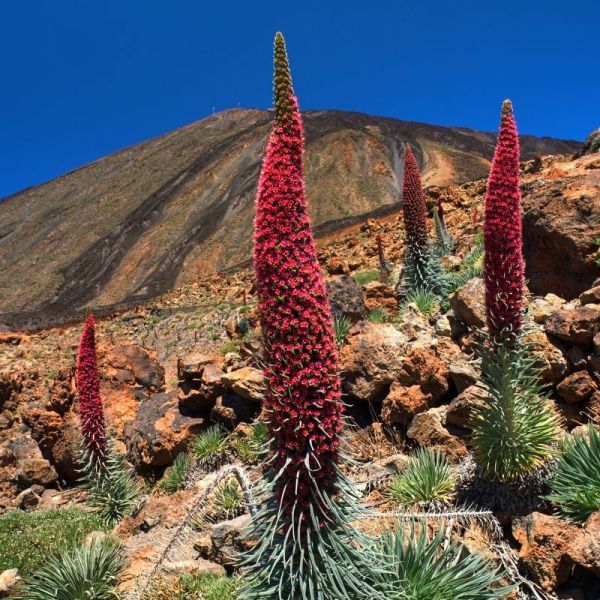Echium Wildpretii Seeds (Tower of Jewels Seeds)
Echium Wildpretii Seeds (Tower of Jewels Seeds)
As for most Echium it is favored by bee-keepers for its high nectar and pollen content.

Delivery
All orders shipped with UPS Express.
Always free shipping for orders over US $250.
All orders are shipped with a UPS tracking number.
Returns
Items returned within 14 days of their original shipment date in same as new condition will be eligible for a full refund or store credit.
Refunds will be charged back to the original form of payment used for purchase.
Customer is responsible for shipping charges when making returns and shipping/handling fees of original purchase is non-refundable.
All sale items are final purchases.
Help
Give us a shout if you have any other questions and/or concerns.
Email: contact@domain.com
Phone: +1 (23) 456 789
Availability: In stock
SKU
Echium Wildpretii
Echium wildpretii or Pink Fountain belongs to the Boraginaceae family and is an herbaceous biennial plant that grows up to 3 m in height. The species is endemic to the island of Tenerife in the Canary Island, and is found mainly in Las Ca¤adas del Teide. This evergreen plant can be found as a garden ornamental but is intolerant of low temperatures. As for most Echium it is favored by bee-keepers for its high nectar and pollen content.
Wildpretii is short-lived but is an interesting plant that produces a basal dense rosette of narrow hairy silvery leaves during the first year and in the third year produces an erect inflorescence between 1 and 3 m tall (50 cm). The plant blooms from late spring to early summer. The plant dies after fruiting, leaving lots of seeds. This plant is attractive to bees, butterflies and birds!
Echium wildpretii is a very showy tower indeed. This amazing plant can grow up to 10 feet tall (150-300 cm), but 6 feet is more usual. It doesn't grow much in its first year, but concentrates on sending down a very thick tap root. The next year it grows a lot but usually they don?t flower in year two.
The narrow silvery-grey leaves have a stiff texture. You can expect flowers in year three, and these are impressive and worth the wait. The wildpretii flowers from March to May in the lower regions or August in the mountains. From the centre of the Tower of Jewels rosette, grows a stately inflorescence with thousands of coral-pink flowers, which forms a thick column, sometimes up to 1 foot thick. Then the plant dies! If you have this plant, be sure to collect the seeds so you can re-sow them next spring!
Hardiness zones:
8-11(-10c/15f, 4c/40f). The plant grows in the sub alpine zone of the ravines of Teide. It requires a lot of sun and is found in arid and dry conditions but is frost tolerant down to -5 §C. This plant prefers a well-drained soil, made up of 10% humus 30% sand and 60% crushed lava or pumice, and is drought-tolerant, making it suitable for xeriscaping. It is an excellent plant for; seaside garden, shrub borders and containers. Be careful, handling the plant may cause skin irritation or allergic reaction.
| Label | Echium wildpretii |
|---|---|
| Common name | Tower of Jewels |
| Genus | Echium |
| Species | Echium wildpretii |
| Germination | Sow the Echium wildpretii seeds about 6mm deep in 10 cm plastic pots, with well drained seed sowing mix. Keep the pots in a cool spot with direct sun, so that during the day the soil heats up to some 20øC to 25øC. At night temperature should fall to some 5øC to 10øC. Germination may be inhibited if the pots are kept constantly warm. Always keep the soil only slightly moist in order to prevent fungal infections of seedlings. Usually seeds will germinate rapidly within 2-4 weeks. However certain seeds may need several months to germinate properly, thus do not throw away pots with un-germinated seeds, but keep them always slightly moist in a sunny spot. As soon as seedlings appear, keep pots in a sunny spot. Transplant the seedlings to 20cm (5L) pots as soon as the fifth pair of real leaves has appeared. Transplant the Echium wildpretii to a final pot size of some 10 L as soon as rosettes have gained some 30cm in diameter. Water plants regularly from beneath and never let the soil dry completely. Add some common all-purpose fertilizer in half the concentration as directed and feed plants once every week from May to end of September. Keep container plants frost-free in winter (from October through the end of April) at a minimum of some 10øC in a very sunny spot. Reduce watering, unless plants are grown under heated glass, when they will require more moisture. The plants are frost resistant down to -10øC or even less in winter. However in habitat temperatures rise significantly above +10øC or more at daytime. |
| Price View | Price Range |

